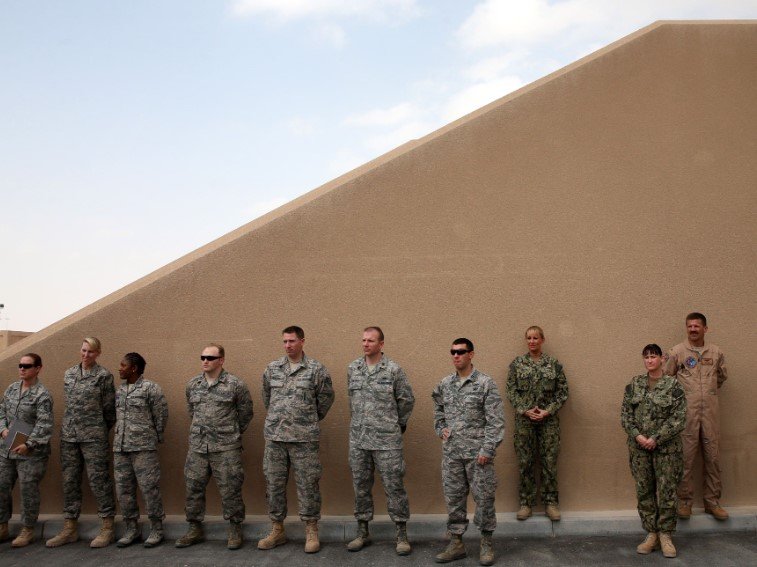A string of American military installations across the Middle East has gone into heightened readiness after the U.S. launched missile strikes on Iran’s key nuclear facilities — a move that’s already ignited fears of regional war.
The Pentagon’s forward bases, long scattered across deserts, coastlines, and contested borders, are once again bracing for potential fallout. Tehran has vowed to respond “at a time and place of its choosing,” prompting alerts at installations stretching from Iraq to the Gulf.
No one’s calling it a war yet — but the runway lights are blinking, jets are refueled, and every eye is on the radar.
US Firepower Spreads Across the Map
The United States has spent decades building and reinforcing its military footprint across the Middle East — some of it visible, some not so much.
At least eight major airbases are on what’s effectively a wartime footing following Sunday’s strikes on Natanz, Fordow, and Arak — Iran’s core nuclear infrastructure. Sources with knowledge of US Central Command’s posture say these are the sites now on full alert:
-
Al Udeid Air Base, Qatar
-
Al Dhafra Air Base, UAE
-
Al Asad Air Base, Iraq
-
Incirlik Air Base, Turkey
-
Muwaffaq Salti Air Base, Jordan
-
Ali Al Salem Air Base, Kuwait
-
Prince Sultan Air Base, Saudi Arabia
-
Camp Arifjan, Kuwait
Each of these locations plays a different role in the US strategic chessboard. Some house fighter squadrons. Others host drone operations or act as logistics hubs. But all are now expecting the unexpected.

Why These Bases Matter — And What They Host
Some of the bases, like Al Udeid in Qatar, are practically mini-cities. Home to the forward headquarters of CENTCOM, the base reportedly hosts over 10,000 US personnel. It’s a nerve center for air operations across the region.
Others like Al Asad in Iraq are less about size and more about location. It’s from here that US Marines flew electronic warfare missions during Operation Iraqi Freedom. In 2020, it was also the target of Iranian ballistic missiles — retaliation for the killing of Qasem Soleimani.
Here’s a quick snapshot of their functions:
| Base | Country | Function | Estimated US Troops |
|---|---|---|---|
| Al Udeid | Qatar | Command & control, air ops | ~10,000 |
| Al Dhafra | UAE | F-35 and ISR aircraft | ~3,500 |
| Al Asad | Iraq | Support base, drones | ~1,500 |
| Incirlik | Turkey | NATO operations | ~2,500 |
| Muwaffaq Salti | Jordan | Drone & strike ops | ~1,000 |
| Ali Al Salem | Kuwait | Logistic hub | ~1,500 |
| Prince Sultan | Saudi Arabia | Missile defense, radar | ~2,000 |
| Camp Arifjan | Kuwait | Ground troop logistics | ~9,000 |
That’s a lot of boots, wings, and hardware — and it explains why the US isn’t blinking right now.
Tehran’s Threat: Retaliate, But How?
Iran’s official response, so far, has been rhetorical. Foreign Minister Hossein Amir-Abdollahian condemned the strikes and warned of “swift and severe consequences.” But there’s speculation in Western intelligence circles that the regime will opt for asymmetrical tactics — not a head-on military clash.
That means:
-
Attacks on US bases by proxy militias
-
Drone and missile salvos launched from Yemen, Iraq, or Syria
-
Cyber assaults targeting command systems or energy infrastructure
Iran has tested all these tools before.
Back in January, Iran-aligned groups lobbed rockets at Erbil Air Base in Iraqi Kurdistan. The Houthis, meanwhile, have been increasingly aggressive with drone attacks into Saudi Arabia and the Red Sea shipping lanes. With Sunday’s strike, the fuse may now be lit.
Allies, Air Defense, and a Nervous Gulf
The Gulf states are watching — nervously. While most are US allies, none of them want war on their doorstep. Saudi Arabia and the UAE, in particular, are threading a fine line: allowing the US to operate from their soil, while urging restraint to avoid becoming collateral damage.
In Riyadh, defense systems were reportedly put on standby late Sunday. The Patriot batteries at Prince Sultan Air Base were repositioned, and civilian air traffic was quietly rerouted.
Over in Kuwait, local media say authorities have ramped up coordination with US commanders at Camp Arifjan and Ali Al Salem. Jordan has issued vague warnings to “external actors,” without naming Iran outright.
Inside CENTCOM: Simulators, Sirens, and Shadow Games
Inside CENTCOM’s nerve centers — especially at Al Udeid — the mood is businesslike but tense. Simulations of Iranian missile trajectories, drills on base lockdowns, and constant UAV surveillance are standard fare now.
A defense official familiar with operations said command staff were rotating in longer shifts to maintain readiness. “Nobody’s sleeping normal hours right now,” he said. “It’s not panic — it’s preemption.”
There’s also the added challenge of info-warfare. Iran’s online disinformation machine, backed by the IRGC’s cyber wing, has been feeding Arabic-language propaganda about the US strikes. Platforms like Telegram and X (formerly Twitter) are being closely watched by US cyber teams.
One small paragraph to breathe.
Trump’s Gamble and the 2024 Shadow
The strikes on Iran come less than five months after Donald Trump’s return to the White House — and already, the Middle East is back on the brink. In public remarks, Trump said the US “would never allow Iran to become a nuclear threat to the world.”
It’s unclear how far this doctrine goes.
Critics — both inside Washington and out — argue the escalation could ignite a conflict the US cannot easily control. Others, especially Trump’s backers, see it as a bold deterrent message.
Iran, as always, remains unpredictable.
